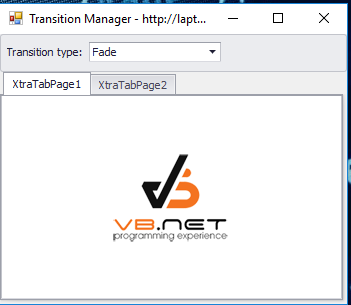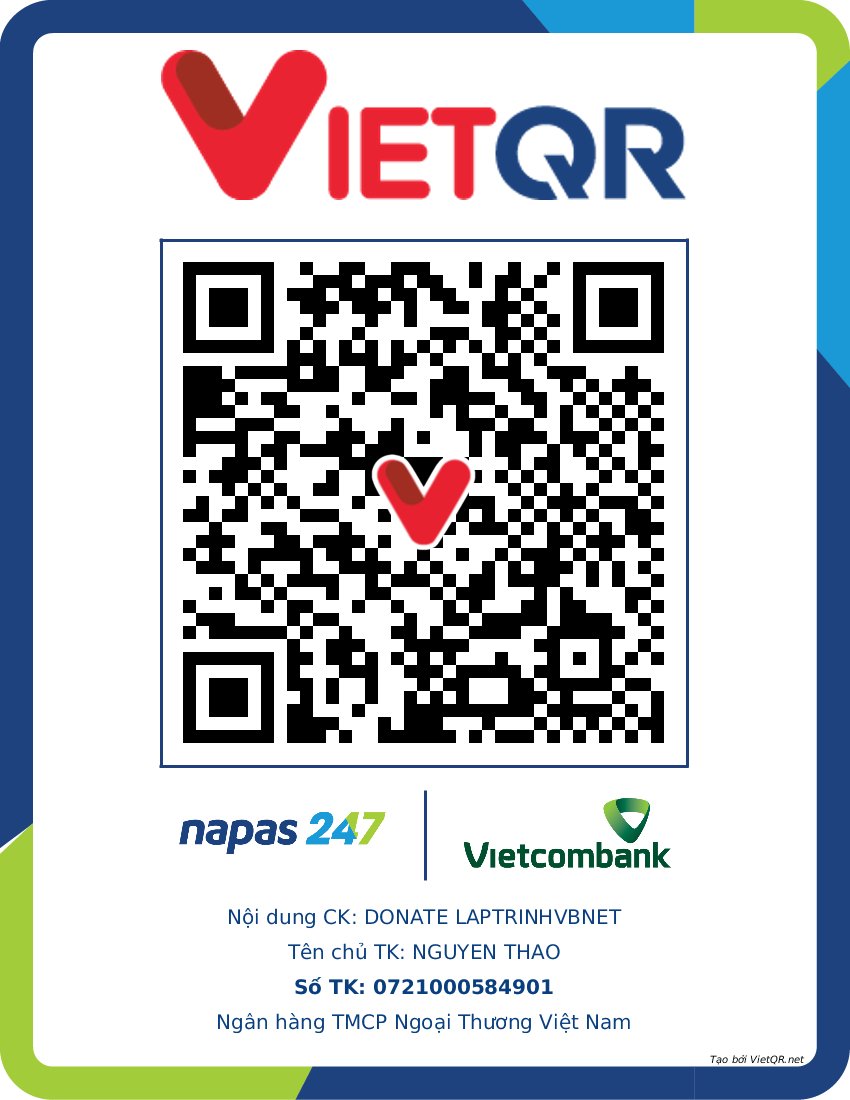- KHI Sل»° TINH GIل؛¢N Lأ€ ؤگل»ˆNH CAO Cل»¦A Cأ”NG NGHل»† BأپN Hأ€NG 2026 - PHل؛¦N Mل»€M BأپN Hأ€NG BASYS
- Phل؛§n mل»پm bأ،n hأ ng cho hل»™ kinh doanh BASYS ؤ‘ئ،n giل؛£n أt thao tأ،c
- [C#] Hئ°ل»›ng dل؛«n tأch hل»£p thأھm menu vأ o System menu cل»§a ل»©ng dل»¥ng
- [DEVEXPRESS] Hل»— trل»£ tأ¬m kiل؛؟m highlight khأ´ng dل؛¥u vأ khأ´ng khoل؛£ng cأ،ch trأھn Gridview Filter
- [C#] Chia sل؛» source code phل؛§n mل»پm Image Downloader tل؛£i hأ ng loل؛،t hأ¬nh ل؛£nh tل»« danh sأ،ch link url
- [C#] Chل»¥p hأ¬nh vأ quay video tل»« camera trأھn winform
- [C#] Chia sل؛½ full source code tأ،ch file Pdf thأ nh nhiل»پu file vل»›i cأ،c tأ¹y chل»چn
- Giل»›i thiل»‡u vل»پ Stock Tracker Widget - Cأ´ng cل»¥ theo dأµi cل»• phiل؛؟u vأ cل؛£nh bأ،o giأ، tؤƒng giل؛£m bل؛±ng C# vأ WPF
- [VB.NET] Chia sل؛» cأ´ng cل»¥ nhل؛p sل»‘ tiل»پn tل»± ؤ‘ل»™ng ؤ‘ل»‹nh dل؛،ng tiل»پn tل»‡ Viل»‡t Nam
- [VB.NET] Hئ°ل»›ng dل؛«n fill dل»¯ liل»‡u tل»« winform vأ o Microsoft word
- [VB.NET] Hئ°ل»›ng dل؛«n chل»چn nhiل»پu dأ²ng trأھn Datagridview
- Hئ°ل»›ng Dل؛«n ؤگؤƒng Nhل؛p Nhiل»پu Tأ i Khoل؛£n Zalo Trأھn Mأ،y Tأnh Cل»±c Kل»³ ؤگئ،n Giل؛£n
- [C#] Chia sل؛» source code phل؛§n mل»پm ؤ‘ل؛؟m sل»‘ trang tل؛p tin file PDF
- [C#] Cأ،ch Sل» Dل»¥ng DeviceId trong C# ؤگل»ƒ Tل؛،o Khأ³a Cho ل»¨ng Dل»¥ng
- [SQLSERVER] Loل؛،i bل»ڈ Restricted User trأھn database MSSQL
- [C#] Hئ°ل»›ng dل؛«n tل؛،o mأ£ QRcode Style trأھn winform
- [C#] Hئ°ل»›ng dل؛«n sل» dل»¥ng temp mail service api trأھn winform
- [C#] Hئ°ل»›ng dل؛«n tل؛،o mأ£ thanh toأ،n VietQR Pay khأ´ng sل» dل»¥ng API trأھn winform
- [C#] Hئ°ل»›ng Dل؛«n Tل؛،o Windows Service ؤگئ،n Giل؛£n Bل؛±ng Topshelf
- [C#] Chia sل؛» source code ؤ‘ل»چc dل»¯ liل»‡u tل»« Google Sheet trأھn winform
[DEVEXPRESS] Hئ°ل»›ng dل؛«n tل؛،o hiل»‡u ل»©ng di chuyل»ƒn qua lل؛،i cأ،c tab sل» dل»¥ng Transition Manager
Hأ´m nay, mأ¬nh xin hئ°ل»›ng dل؛«n cأ،c bل؛،n tل؛،o hiل»‡u ل»©ng, khi di chuyل»ƒn qua lل؛،i giل»¯a cأ،c tab sل» dل»¥ng Transition Manager trong bل»™ cأ´ng cل»¥ Devexpress.
Transition Manger cung cل؛¥p cho chأ؛ng ta rل؛¥t nhiل»پu hiل»‡u ل»©ng bao gل»“m: Fade, clock, Dissolve, Shape, SlideFade, Cover, Comb.
Giao diل»‡n chئ°ئ،ng trأ¬nh:آ

Video Demo :
Source code cho ل»©ng dل»¥ng:
Imports DevExpress.Utils.Animation
Imports DevExpress.XtraEditors
Public Class Form1
Dim animatedControl As Control
Private Sub Form1_Load(sender As Object, e As EventArgs) Handles MyBase.Load
animatedControl = XtraTabControl1
' Populate the ImageComboBox with available transition types.
ImageComboBoxEdit1.Properties.Items.AddEnum(GetType(DevExpress.Utils.Animation.Transitions))
AddHandler ImageComboBoxEdit1.SelectedIndexChanged, AddressOf ImageComboBoxEdit1_SelectedIndexChanged
ImageComboBoxEdit1.SelectedIndex = 0
End Sub
Private Sub ImageComboBoxEdit1_SelectedIndexChanged(sender As Object, e As EventArgs)
Dim imComboBox As ImageComboBoxEdit = TryCast(sender, ImageComboBoxEdit)
If TransitionManager1.Transitions(animatedControl) Is Nothing Then
' Add a transition, associated with the xtraTabControl1, to the TransitionManager.
Dim transition1 As New Transition()
transition1.Control = animatedControl
TransitionManager1.Transitions.Add(transition1)
End If
' Specify the transition type.
Dim trType As DevExpress.Utils.Animation.Transitions = DirectCast(imComboBox.EditValue, DevExpress.Utils.Animation.Transitions)
TransitionManager1.Transitions(animatedControl).TransitionType = CreateTransitionInstance(trType)
End Sub
Private Function CreateTransitionInstance(transitionType As Transitions) As BaseTransition
Select Case transitionType
Case Transitions.Dissolve
Return New DissolveTransition()
Case Transitions.Fade
Return New FadeTransition()
Case Transitions.Shape
Return New ShapeTransition()
Case Transitions.Clock
Return New ClockTransition()
Case Transitions.SlideFade
Return New SlideFadeTransition()
Case Transitions.Cover
Return New CoverTransition()
Case Transitions.Comb
Return New CombTransition()
Case Else
Return New PushTransition()
End Select
End Function
Private Sub XtraTabControl1_SelectedPageChanging(sender As Object, e As DevExpress.XtraTab.TabPageChangingEventArgs) Handles XtraTabControl1.SelectedPageChanging
' Start the state transition when a page is about to be switched.
If animatedControl Is Nothing Then
Return
End If
TransitionManager1.StartTransition(animatedControl)
End Sub
Private Sub XtraTabControl1_SelectedPageChanged(sender As Object, e As DevExpress.XtraTab.TabPageChangedEventArgs) Handles XtraTabControl1.SelectedPageChanged
' Finish the transition after a page has been selected.
TransitionManager1.EndTransition()
End Sub
' A custom easing function.
Dim myEasingFunc As DevExpress.Data.Utils.IEasingFunction = New DevExpress.Data.Utils.BackEase()
Private Sub TransitionManager1_CustomTransition(transition As DevExpress.Utils.Animation.ITransition, e As DevExpress.Utils.Animation.CustomTransitionEventArgs) Handles TransitionManager1.CustomTransition
' Set a clip region for the state transition.
e.Regions = New Rectangle() {XtraTabPage1.Bounds}
' Specify a custom easing function.
e.EasingFunction = myEasingFunc
End Sub
End ClassSource code sل» dل»¥ng C#
using System;
using System.Collections.Generic;
using System.ComponentModel;
using System.Data;
using System.Drawing;
using System.Linq;
using System.Text;
using System.Windows.Forms;
using DevExpress.Utils.Animation;
using DevExpress.XtraEditors;
using DevExpress.XtraEditors.Controls;
namespace TransitionManagerSample {
public partial class Form1 : Form {
public Form1() {
InitializeComponent();
}
Control animatedControl;
private void xtraTabControl1_SelectedPageChanging(object sender, DevExpress.XtraTab.TabPageChangingEventArgs e) {
// Start the state transition when a page is about to be switched.
if (animatedControl == null) return;
transitionManager1.StartTransition(animatedControl);
}
private void xtraTabControl1_SelectedPageChanged(object sender, DevExpress.XtraTab.TabPageChangedEventArgs e) {
// Finish the transition after a page has been selected.
transitionManager1.EndTransition();
}
private void Form1_Load(object sender, EventArgs e) {
animatedControl = xtraTabControl1;
// Populate the ImageComboBox with available transition types.
imageComboBoxEdit1.Properties.Items.AddEnum(typeof(DevExpress.Utils.Animation.Transitions));
imageComboBoxEdit1.SelectedIndexChanged += imageComboBoxEdit1_SelectedIndexChanged;
imageComboBoxEdit1.SelectedIndex = 0;
}
BaseTransition CreateTransitionInstance(Transitions transitionType) {
switch (transitionType) {
case Transitions.Dissolve: return new DissolveTransition();
case Transitions.Fade: return new FadeTransition();
case Transitions.Shape: return new ShapeTransition();
case Transitions.Clock: return new ClockTransition();
case Transitions.SlideFade: return new SlideFadeTransition();
case Transitions.Cover: return new CoverTransition();
case Transitions.Comb: return new CombTransition();
default: return new PushTransition();
}
}
void imageComboBoxEdit1_SelectedIndexChanged(object sender, EventArgs e) {
ImageComboBoxEdit imComboBox = sender as ImageComboBoxEdit;
if (transitionManager1.Transitions[animatedControl] == null) {
// Add a transition, associated with the xtraTabControl1, to the TransitionManager.
Transition transition1 = new Transition();
transition1.Control = animatedControl;
transitionManager1.Transitions.Add(transition1);
}
// Specify the transition type.
DevExpress.Utils.Animation.Transitions trType = (DevExpress.Utils.Animation.Transitions)imComboBox.EditValue;
transitionManager1.Transitions[animatedControl].TransitionType = CreateTransitionInstance(trType);
}
// A custom easing function.
DevExpress.Data.Utils.IEasingFunction myEasingFunc = new DevExpress.Data.Utils.BackEase();
private void transitionManager1_CustomTransition(DevExpress.Utils.Animation.ITransition transition, DevExpress.Utils.Animation.CustomTransitionEventArgs e) {
// Set a clip region for the state transition.
e.Regions = new Rectangle[] { xtraTabPage1.Bounds };
// Specify a custom easing function.
e.EasingFunction = myEasingFunc;
}
}
}Chأ؛c cأ،c bل؛،n thأ nh cأ´ng. Mل»چi cأ¢u hل»ڈi thل؛¯c mل؛¯c ؤ‘ل؛؟n bأ i viل؛؟t xin truy cل؛pآ http://hoidap.laptrinhvb.netآ ؤ‘ل»ƒ ؤ‘ئ°ل»£c support.
ؤگل»ھNG QUأٹN LIKE AND SHARE NHA CأپC Bل؛ N.آ
CأپM ئ N CأپC Bل؛ N ؤگأƒ THEO Dأ•I.


